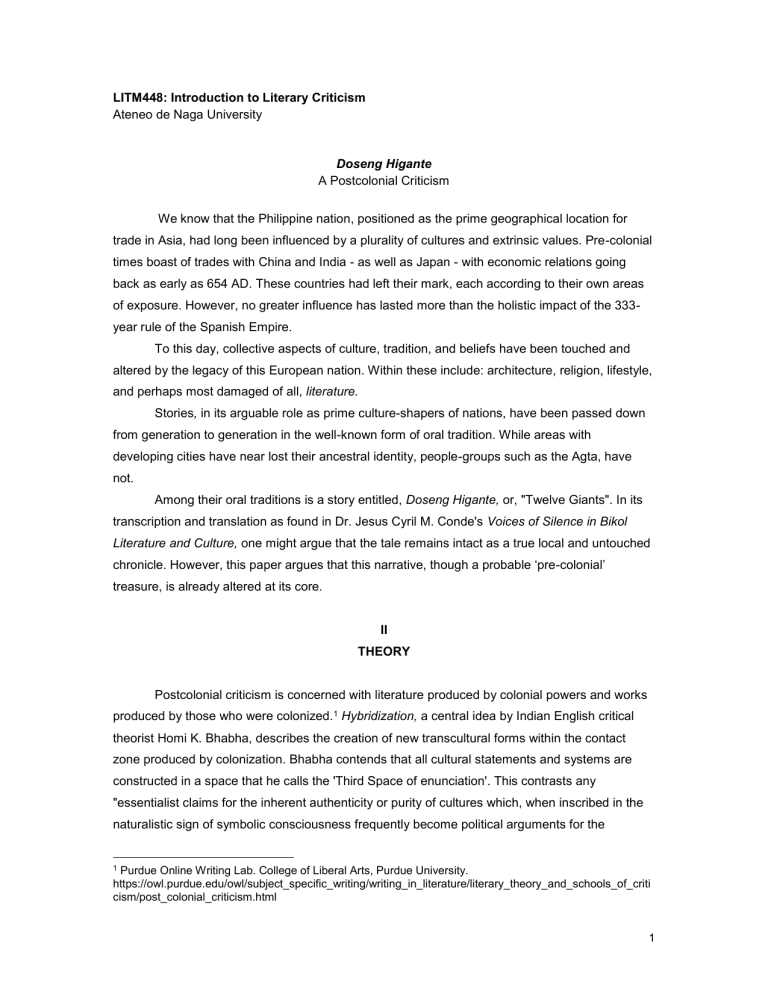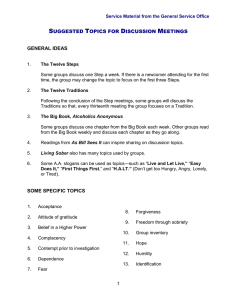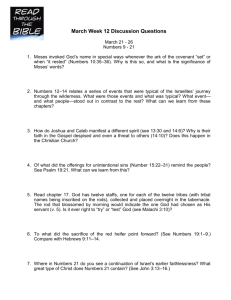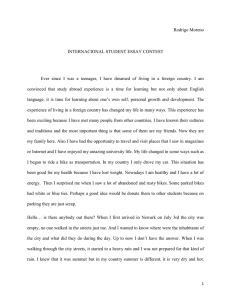Doseng Higante / Twelve Giants - Post Colonialism Paper
advertisement

LITM448: Introduction to Literary Criticism Ateneo de Naga University Doseng Higante A Postcolonial Criticism We know that the Philippine nation, positioned as the prime geographical location for trade in Asia, had long been influenced by a plurality of cultures and extrinsic values. Pre-colonial times boast of trades with China and India - as well as Japan - with economic relations going back as early as 654 AD. These countries had left their mark, each according to their own areas of exposure. However, no greater influence has lasted more than the holistic impact of the 333year rule of the Spanish Empire. To this day, collective aspects of culture, tradition, and beliefs have been touched and altered by the legacy of this European nation. Within these include: architecture, religion, lifestyle, and perhaps most damaged of all, literature. Stories, in its arguable role as prime culture-shapers of nations, have been passed down from generation to generation in the well-known form of oral tradition. While areas with developing cities have near lost their ancestral identity, people-groups such as the Agta, have not. Among their oral traditions is a story entitled, Doseng Higante, or, "Twelve Giants". In its transcription and translation as found in Dr. Jesus Cyril M. Conde's Voices of Silence in Bikol Literature and Culture, one might argue that the tale remains intact as a true local and untouched chronicle. However, this paper argues that this narrative, though a probable ‘pre-colonial’ treasure, is already altered at its core. II THEORY Postcolonial criticism is concerned with literature produced by colonial powers and works produced by those who were colonized.1 Hybridization, a central idea by Indian English critical theorist Homi K. Bhabha, describes the creation of new transcultural forms within the contact zone produced by colonization. Bhabha contends that all cultural statements and systems are constructed in a space that he calls the 'Third Space of enunciation'. This contrasts any "essentialist claims for the inherent authenticity or purity of cultures which, when inscribed in the naturalistic sign of symbolic consciousness frequently become political arguments for the 1 Purdue Online Writing Lab. College of Liberal Arts, Purdue University. https://owl.purdue.edu/owl/subject_specific_writing/writing_in_literature/literary_theory_and_schools_of_criti cism/post_colonial_criticism.html 1 hierarchy and ascendary of powerful cultures."2 The writer will analyze Doseng Higante according to the following questions: 1. What does the text reveal about the problematics of post-colonial identity, including the relationship between personal and cultural identity and such issues as double consciousness and hybridity? 2. What does the text reveal about the operations of cultural difference - the ways in which race, religion, class, gender, sexual orientation, cultural beliefs, and customs combine to form individual identity - in shaping our perceptions of ourselves, of others, and of the world in which we live? In addition to this framework, we will look at key parts of the story, and single out elements that are possible outcomes of hybridity, along with alterations prompted by the side of the known colonizers. III ANALYSIS 3.1 Symbolic Elements 3.1.1 Paragraph 1: "To make it short, they had a child named Rodrigo." "Rodrigo" is a Spanish and Portuguese name derived from the Germanic name, Roderick. The name is frequently given in Portugal, and was the most popularly given masculine name in 2011-2012. It is also moderately popular in Spain, ranking between 30th and 60th most popular during the years 2002-2015.3 The use of the name Rodrigo for the main character suggests the already-influenced naming culture patterned after the customs of Spanish colonizers. In fact, these days, it is rare to think of or remember names that are traditionally and "purely" Filipino, names that are untainted and not found in association with other foreign cultures. 3.1.2 Paragraph 27: "The kid got the necklace made of kawela. 'But, my instruction is that when you wear this around your neck, you never remove it until death. Take care of this. This thing will save you in times of problems and dangers. Just call the twelve giants.' " The use of jewelry as magical objects is not uncommon in Philippine tradition, having been frequently used in the custom of occults to ward off evil or to protect them from some specific thing. These objects have many terms: among them include ‘amulet’, or the agimat and anting-anting. In this story, Rodrigo's acquiring of them is intended for the purpose of keeping him away from danger, though he proceeds to use them even if there are few dangers lurking about. 2 3 Bhabha, Homi K. The Location of Culture. 1994. London: Routledge. https://www.behindthename.com/name/rodrigo/top/portugal 2 The western alteration, however, of this native custom is evident in the powers that show up whenever Rodrigo calls upon the necklace. Let's discuss the Twelve Giants. Giants, first of all, have long been part of Philippine mythological beliefs. They have had their fair share of appearances in folklore found in different regions; some examples would be the Bungisngis, a one-eyed giant,4 also known as 'Mahentoy' in northern Davao, and the Kapre, known as a Filipino 'bigfoot' who scares away little children who play at night.5 While the 'giant' factor is a native element, the focus of the western influence lies on the featured number, twelve. The number twelve is a highly distinct number. It is deeply regarded in all branches of Christianity, including Catholicism, the religion promulgated by the Spaniards. First appearing in the book of Genesis and found all over the rest of the biblical Scriptures, the number twelve may be interpreted as a symbol to represent God's kingdom, perfect government, and divine authority. Prime examples of these are the twelve tribes of Israel 6 and the twelve disciples of Christ.7 The designated number twelve (12) in the number of the giants who attend to Rodrigo's needs may arguably be interpreted as 'perfect', as in: having twelve protectors would be the perfect number to ensure divine coverage for any and all kinds of dangers that may befall the user of the necklace. The necklace, taking its derivation from native supernatural customs, holds its source as inherently Filipino, however, the resulting display of power becomes bequeathingly Western. This mythical object then becomes the resulting, concealed symbol of power, and therefore authority, that was transferred from the natives to the foreigners. This power, though already fully evident in politics and education, presents itself as eternally and hauntingly present in oral literature as well. 3.1.3 Paragraph 36: "After a while, a soldier came out. 'Don Rodrigo, you were able to carry that tree? You are still very small,' " and Paragraph 43: "He fell in love with the daughter of the king named Doña Maria." Don and Doña are honorifics used in countries such as Spain, Portugal, Italy, IberoAmerica, and the Philippines. Originally reserved for royalty and church hierarchs, this honorific is now often used as a mark of esteem for any person of distinction, such as a person of significant wealth or status. It may also be used ironically and sarcastically. In Spanish colonial Philippines, this title was reserved to the Datu, one whose right to rule was recognized by the Spanish king. 8 The use of these honorifics in the story confirms the assimilation of the Don and Doña 4 Ramos, Maximo D. Creatures of Philippine Lower Mythology, 1990. Quezon: Phoenix Publishing. p. 76. Clark, Jordan. "Origin of the Kapre, the cigar smoking giant from the Philippines". The Aswang Project. https://www.aswangproject.com/origin-kapre/ 6 Genesis 49:28. Holy Bible: New American Standard Bible. 1995. LaHabra, CA: The Lockman Foundation. 7 Matthew 10:1. Holy Bible: New American Standard Bible. 1995. LaHabra, CA: The Lockman Foundation. 8 Barangay in Enciclopedia Universal Ilustrada Europea-Americana, Madrid: Espasa-Calpe, S. A., 1991, Vol. VII, p.624 5 3 titles in Philippine culture. It is rightfully fitting for Maria to have the Doña title, as she is the daughter of the king. Rodrigo, on the other hand, became a recipient of the title after being rewarded and held in regard in the crocodile king's kingdom. 3.1.4 Paragraph 69: "When the mampak saw them, it punched Rodrigo. Since Rodrigo was still weak, he could not say anything. He was brought to Calvary and tied to a cross." The presence of the concept of Calvary, as well as the act of being tied to a cross as punishment, solidifies the colonial impact in the narrative of the story; with the cross being the defining event of the birth of Christianity. 4.1 Post-colonial Identity This text reveals important points of assimilated culture within the context of the narrated story; particularly: naming culture, use of honorifics, and key concepts in the colonizer's enforced religion. The personal identity of the main character himself is western-influenced, beginning with his most basic knowledge of his own persona - his name. Issues such as hybridity are present and persistent all-throughout the narrative. Individual identity, as exhibited by Rodrigo, is formed through his environment's surrounding available sources, which, as we have analyzed is heavily hybrid. His perception of himself as a Don after receiving the kawela necklace, his experience being brought to Calvary on a cross, all have formed his more mature growth at the end of the story. IV CONCLUSION Doseng Higante, though valued as a long-standing passed-down narrative for generations, is majorly altered in its roots, and cannot be regarded as a purist example of Filipino culture. The 3-5 generational gaps between the Philippines we were then, and the Philippines we are now are too far related, and we can only assume that all the stories collected from our ancestors are tainted by this experience as well. We can hope to build our culture now, with all that we have before us. 4




